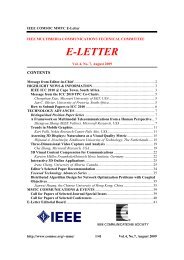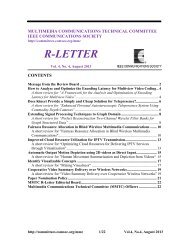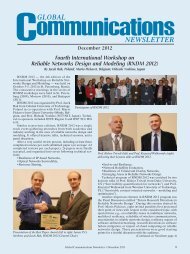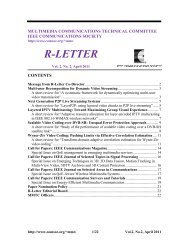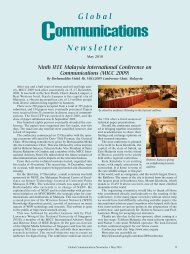PRISM - vol. 1, no. 3 - IEEE Communications Society
PRISM - vol. 1, no. 3 - IEEE Communications Society
PRISM - vol. 1, no. 3 - IEEE Communications Society
Create successful ePaper yourself
Turn your PDF publications into a flip-book with our unique Google optimized e-Paper software.
P R I S M<br />
VOL. 1 NO. 3
ONTC <strong>PRISM</strong> Newsletter<br />
Dear ONTC Members,<br />
A warm welcome from the Editorial desk of the ONTC’s newsletter “Prism”. It is our pleasure to bring to<br />
you this third edition of <strong>PRISM</strong> – ONTC’s quarterly newsletter. The industry is moving towards two interesting<br />
trends, of consolidation and new business models. Providers and vendors are both adopting new business models as<br />
well as new tech<strong>no</strong>logies that will have a significant impact<br />
The current month focuses on carrier class tech<strong>no</strong>logies for packet based telecommunication networks. We<br />
have in this issue a good fit between academia and industry, covering various aspects of packet backbones that are<br />
making up much of transport networks. The impact of transport networks is important from the larger<br />
telecommunication business perspective.<br />
The industry just concluded the <strong>IEEE</strong> 802 Standards’ Plenary in San Diego. The next 802 plenary will be<br />
held in Dallas, in November. It will be encouraging to see more academics participate in the .1 and .3 sessions. The<br />
ITU study group meets next on Oct 18-22 in Geneva.<br />
In this issue of Prism we bring to you 3 articles on a wide range of topics. The first article is by Nurit<br />
Spreecher and Yacov Weingarten from Nokia Siemens Networks who describe in detail the working of the<br />
emerging Ethernet standard of MPLS-TP. The MPLS Transport Profile tech<strong>no</strong>logy is being heralded by vendors and<br />
providers as the new way to transport Ethernet across large networks achieving low-cost and making much use of<br />
the existing MPLS infrastructure. The authors describe the work in the standards, the tech<strong>no</strong>logical manifestations<br />
and operational issues pertaining to MPLS-TP<br />
The second article describes the other alternate tech<strong>no</strong>logy for Carrier Ethernet transport. The article<br />
written by David Allan, (Ericcson) Peter Ashwood-Smith, (Huawei) Nigel Bragg, (Ciena) Já<strong>no</strong>s Farkas, (Ericcson)<br />
Don Fedyk, (Alcatel-Lucent) Mick Seaman, Paul Unbehagen (Alcatel-Lucent) talks for the new 802.1as emerging<br />
standard on shortest path bridging. The Shortest Path Bridging or SPB tech<strong>no</strong>logy gives a significant edge to PBB-<br />
TE networking and has been explained in sufficient detail in the article. The authors point out to a forthcoming<br />
longer article on the same topic in the Sept issue of <strong>IEEE</strong> <strong>Communications</strong> Magazine.<br />
The third article is by Mohit Chamania, Admela Jukan, Oscar Gonzales de Dios, Javier Jimenez Chico on<br />
offloading excess IP traffic with optical bypass. The article is important to providers from an opex savings<br />
perspective and gives a new direction to optical networking research, especially making them more relevant to<br />
IP/MPLS networks. The article paves a way to a more pragmatic view of IP over WDM optical networks.<br />
As you are aware the editorial desk does highlight events, call for papers and new standards work – all of<br />
which would be relevant information for our readers. So please do send in any such information that you would like<br />
to see online for the next issue of Prism!<br />
We also do hope readers would send in their thoughts on how to make Prism better – we would be happy to<br />
publish their messages even if all of these can<strong>no</strong>t be adopted at the same time!<br />
We invite prospective authors send articles of up to 4 pages (single column, 10 point font, with all one-inch<br />
margins) to submissions@ontc-prism.org. The deadline for reception of articles is Sept 30, 2010 for the next issue of<br />
Prism.<br />
On behalf of the TAB we are thankful to the <strong>IEEE</strong> Communication <strong>Society</strong> as well as to the ONTC officers<br />
Byrav, Suresh, Admela and Dominic who have supported us in making this newsletter happen.<br />
It is our hope that the newsletter would bring the community together and identifying areas of growth and<br />
common interest.<br />
Ashwin Gumaste, IIT Bombay.<br />
ONTC Newsletter, “Prism” Vol. 1. No. 3. August 2010
Message Board<br />
Standardization:<br />
<strong>IEEE</strong> SIEPON<br />
http://grouper.ieee.org/groups/1904/1/<br />
<strong>IEEE</strong> Interim Meeting Sept 13-16, York, UK http://www.ieee802.org/1/meetings/index.html#sep10gen<br />
(802)<br />
IETF Nov 7-11, Beiging, China http://www.ietf.org/meeting/79/index.html<br />
<strong>IEEE</strong> Plenary Nov 7-11, Dallas, USA http://ieee802.facetoface-events.com/future<br />
ITU SG15 Oct 18-22 http://www.itu.int/ITU-T/studygroups/com15/index.asp<br />
Academic Conferences<br />
<strong>IEEE</strong>/OSA OFC 2011 March 6-10. Los Angeles http://www.ofcnfoec.org/<br />
<strong>IEEE</strong> Globecom 2010 CFP March 31<br />
http://www.ieee-globecom.org/<br />
Conf Dec 6-10. Miami<br />
<strong>IEEE</strong> LCN 2010<br />
CFP April 12. Conf Oct http://www.ieeelcn.org/<br />
11-14 Denver, CO.<br />
<strong>IEEE</strong> ICC 2011 CFP Sept. 7:<br />
http://www.comsoc.org/confs/icc/2011/index.php<br />
June 5-9, 2011, Kyoto,<br />
Japan.<br />
<strong>IEEE</strong> ANTS 2010 CFP July 15:<br />
www.ieee-ants.org<br />
Conf: Dec 15-17,<br />
Bombay, India<br />
Infocom 2011 Conf April 10-15,<br />
Shanghai, China.<br />
http://www.ieee-infocom.org/2011/<br />
The next ONTC meeting would also be held in Miami, during <strong>IEEE</strong> Globecom.<br />
We would be happy to include more conferences in the above list, if readers email editor@ontc-prism.org a CFP of<br />
the conference. The conference must be at least technically supported by ONTC or ComSoc to be included in the list<br />
above and follow the ONTC endorsement policy.<br />
Key journals reporting results in the optical networking area:<br />
<strong>IEEE</strong>/OSA Journal of Optical Communication and networks (JOCN)<br />
http://www.opticsinfobase.org/jocn/journal/jon/author.cfm<br />
<strong>IEEE</strong>/OSA Journal of Lightwave Tech<strong>no</strong>logy: http://ieeexplore.ieee.org/xpl/RecentIssue.jsp?punumber=50<br />
<strong>IEEE</strong>/ACM Transactions on Networking: http://www.ton.seas.upenn.edu/<br />
<strong>IEEE</strong> <strong>Communications</strong> Magazine: http://mc.manuscriptcentral.com/commag-ieee<br />
<strong>IEEE</strong> Network: http://dl.comsoc.org/ni/<br />
ONTC Newsletter, “Prism” Vol. 1. No. 3. August 2010
MPLS-TP<br />
Nurit Sprecher, Nokia Siemens Networks<br />
Yaacov Weingarten, Nokia Siemens Networks<br />
Introduction:<br />
The e<strong>vol</strong>ution of the Service Provider network is being driven by different factors. A major factor is the<br />
accelerating growth and penetration of new packet based services (such as L2/L3 VPNs, VoIP, IPTV, RAN<br />
backhauling, etc.). This factor provides the SPs with massive growth opportunities to support high BW intensive<br />
services that require a guaranteed SLA. In addition, the need to increase their revenue, while remaining competitive,<br />
forces service providers to look for the lowest network Total Cost of Ownership (TCO). A single, simple, end-toend<br />
manageable, packet based network architecture supporting multiple solutions (such as mobile backhauling,<br />
enterprise and residential services, etc.) would give service providers the flexibility to rapidly deploy new revenue<br />
generating services in an eco<strong>no</strong>mic way.<br />
For many years, SONET/SDH has provided service providers with a high benchmark of reliability and operational<br />
simplicity. When migrating to packet based transport networks, some challenges need to be resolved. The solution<br />
must:<br />
be cost effective such that the investments in both CAPEX and OPEX will be minimal.<br />
ensure quality and per service end-to-end SLA, and<br />
support any service (including legacy), at any scale, with global reach (across cities, countries and<br />
continents).<br />
MPLS-TP, the transport profile of MPLS, which is currently being defined in the IETF jointly by the IETF and the<br />
ITU-T, can enable the migration to a packet-based converged network that will easily scale to support Carrier<br />
Ethernet Solutions in a simple and cost-effective way.<br />
MPLS is a mature, proven, and ubiquitous tech<strong>no</strong>logy which already plays an important role in packet networks and<br />
services. It includes both a basic architecture (dealing with forwarding, framing, and encapsulation) and a<br />
comprehensive set of tools. The tool-set supports the ability to –<br />
(1) setup and maintain of reliable and quality transport paths and<br />
(2) enable the delivery of the services.<br />
The IETF/ITU-T Joint Working Team (JWT) was able to show that a great deal of the IETF protocol, design and<br />
architectural work could be reused to meet transport network requirements. The work on MPLS-TP is aimed to<br />
integrate the MPLS transport profile into the IETF MPLS and PWE3 architecture, combining the packet experience<br />
of MPLS with the operational experience of SONET/SDH. This work is being carried out under the following<br />
guiding principles:<br />
(1) reuse (as much as practically possible) existing MPLS standards, and<br />
(2) ensure complete interoperability and architectural soundness with IP/MPLS.<br />
The work on MPLS-TP extends the existing MPLS toolkit with additional architectural elements and mechanisms<br />
that are needed to enable optimal Operational Expenditure for transport requirements. MPLS-TP is a profile of the<br />
extended MPLS toolkit that defines the necessary and sufficient subset of tools which ensure scalable and quality<br />
transport while providing optimal TCO.<br />
It should be <strong>no</strong>ted that by defining a toolkit, these new tools may also be used in an existing IP/MPLS environment<br />
to enhance the general behavior of the network and the services. A toolkit allows SPs to expand and customize their<br />
service offering efficiently with minimal effort.<br />
MPLS-TP Scope:<br />
The scope of MPLS-TP is the packet transport layers. The goal is to enable the delivery of L2, MPLS(-TP) and IP<br />
services over different transmission media with MPLS-TP providing the platform for intelligent and efficient scaling<br />
and traffic engineering.<br />
MPLS-TP supports the separation of the service delivery architecture, in the service layer, from the underlying<br />
transport architecture, in the packet transport layer, in order to provide scalability, efficiency, and security.<br />
The main role of the packet transport layer is to provide connectivity. This connectivity needs to provide efficient,<br />
reliable, long-standing, aggregated (P2P and P2MP) transport paths between service termination or switching<br />
points. The transport paths are transparent to the service creation and modification, thus avoiding unnecessary<br />
protocol complexity. Bandwidth management, resiliency, QoS, OAM, and provisioning are all performed effectively<br />
ONTC Newsletter, “Prism” Vol. 1. No. 3. August 2010
and in a scalable way per the aggregation level. The number of states maintained in the network is relatively low;<br />
being proportional to the number of supported transport paths, independent of the number of services. Packet<br />
forwarding is based on SP-controlled mechanisms and addresses.<br />
The service layer, on the other hand, is service and application aware. It is a high touch networking, which deals<br />
with the dynamic subscriber management and addresses all of the protocol complexity related to BW management,<br />
QoS, resiliency, OAM and provisioning that is configured per service. The number of states maintained at this level,<br />
is proportionate to the number of services supported by the network.<br />
The services are handled at the edges of the packet transport network (service termination/switching points) and are<br />
encapsulated and transmitted transparently across the transport network.<br />
MPLS-TP Data-Plane<br />
MPLS-TP is based on existing pseudowire and LSP constructs and does <strong>no</strong>t modify the MPLS forwarding<br />
architecture. It provides support for unidirectional LSPs, co-routed bidirectional P2P LSPs, and unidirectional P2MP<br />
LSPs. Corouted bidirectional LSPs, consist of two unidirectional LSPs that both traverse the same bidirectional<br />
transport path, and the intermediate <strong>no</strong>des are aware of the pairing relationship between these LSPs.<br />
MPLS-TP supports –<br />
delivery of highly-reliable, differentiated transport services.<br />
<br />
<br />
Traffic Engineering for efficient utilization of network resources.<br />
mechanisms to address QoS (end-to-end BW guaranteed) and performance requirements (such as<br />
throughput, controlled jitter and delay, packet loss, etc.) while utilizing the network resources efficiently<br />
and reliably.<br />
deterministic operation that ensures secured networks and services<br />
MPLS-TP provides efficient transport for all services: Ethernet, TDM, ATM, FR, MPLS(-TP), IP, etc. and<br />
supports all transport service types (p2p, p2mp, mp2mp).<br />
MPLS-TP does place certain restrictions that are a result of the nature of transport networks. These include –<br />
LSP merging is disabled to allow a label to uniquely identify a transport path (as OAM operations require a<br />
packet context).<br />
PHP is disabled by default.<br />
In-band communication Channels:<br />
MPLS-TP defines different in-band communication channels to comply with the following fundamental<br />
requirements:<br />
• MPLS-TP must support the full functionality (i.e. OAM, protection switching, operations, and<br />
configuration) without relying on the existence of a control plane, management plane, and without IP<br />
functionality (encapsulation, routing, and forwarding).<br />
• OAM packets and the user traffic must share the same transport paths. In addition, it must be possible to<br />
differentiate between the different packets<br />
Different communication channels are therefore defined to support the following functions at different nested levels:<br />
OAM functions, Coordination of protection state, Signaling (SCC) and Management (MCC).<br />
To fulfill these requirements, MPLS-TP extends the mechanism that already exists in MPLS - the PW Associated<br />
Channel Header (ACH) that was defined for PW-VCCV [RFC5085]. The extension, the MPLS Generic Associated<br />
Channel (G-ACh), allows MPLS-TP to provide common in-band control channels also at the LSP and link levels.<br />
G-ACh provides support for multiple channels between the end points of the transport path for different control<br />
channels. In order to differentiate the packets intended for the G-ACh, MPLS-TP designated a reserved label (13),<br />
GAL (G-ACh Label), that will appear in all messages. GAL always appears directly below the monitored transport<br />
path label and at the BoS. In addition, the packets include a G-ACh Header that includes a “Channel Type” field<br />
which indicates the type of control channel message that is being carried. This header appears directly after the<br />
GAL in all control packets<br />
OAM<br />
MPLS-TP provides a comprehensive set of OAM tools for fault management and performance monitoring,<br />
supporting the network and the services at different nested levels (i.e. at the end-to-end level, a segment of a path,<br />
and link level). The OAM tools may be used to monitor the network infrastructure, to enhance the general behavior,<br />
and performance level of the network. The tools may also be used to monitor the service level offered to the end<br />
customer, allowing verification of the SLA parameters, and enabling rapid response in the event of a failure or<br />
ONTC Newsletter, “Prism” Vol. 1. No. 3. August 2010
service degradation. The OAM tools help reduce OPEX, minimizing the overhead of trouble shooting, and<br />
enhancing customer satisfaction which, in turn, helps to enable the delivery of high-margin premium services.<br />
All OAM messages in MPLS-TP run in-band (using the G-ACh) and share their fate with data packets.<br />
Architecture: MEPs and MIPs<br />
The OAM architecture is described in the OAM Framework document. The main elements of the architecture are<br />
the Maintenance Entity Group (MEG), i.e. the portion of the transport path that is being monitored or maintained,<br />
the end-points of the MEG, k<strong>no</strong>wn as the MEPs, and the intermediate points that can be monitored, the MIPs. The<br />
OAM messages can be transmitted between the MEPs of a MEG or from a MEP to one of the MIPs (dependent<br />
upon the nature of the OAM message). MIPs, however, do <strong>no</strong>t initiate any OAM message, but may send responses.<br />
A side-effect of this last rule (i.e. that MIPs do <strong>no</strong>t initiate OAM messages) is the reason for the specification of an<br />
additional OAM construct – the Path Segment Tunnel (PST). This construct allows the system to perform OAM<br />
functionality on a segment of a transport path. By configuring the PST at a segment, it allows configuring the endpoints<br />
of the segment to be the MEPs of the PST (originally they are MIPs of the end-to-end transport path) and<br />
thereby allows them to generate the needed OAM messages.<br />
OAM Tools<br />
MPLS-TP supports the following OAM functions:<br />
Continuity Check and Connectivity Verification: used to detect loss of continuity and misconnections<br />
between endpoints. To support pro-active Continuity Check and Connectivity Verification, BFD is being<br />
extended to support the requisite behavior. To support on-demand connectivity verification, LSP-Ping is<br />
being extended to comply with the requirements.<br />
RDI: Used by an endpoint to <strong>no</strong>tify its peer that a defect has been detected on a bidirectional connection<br />
between them. BFD is being extended to include the RDI function within the Continuity Check and<br />
Connectivity Verification messages.<br />
Route Trace: Used to determine the route of a transport path across the MPLS-TP network. LSP-Ping is<br />
extended to comply with the requirements. A new message is being defined for this functionality.<br />
Data-plane loopback: this is an out-of-service message that allows testing of reachability to different points<br />
on the transport path. The intermediate points may support more than one testing point for this<br />
functionality. A new OAM message is being defined for this functionality.<br />
Packet Delay Measurement: used to measure the one-way or two-way delay of packet transmission<br />
between a pair of endpoints. A new message is being defined and the functionality will be based on the<br />
functionality of Y.1731. Note that a certain degree of synchronization of the time clocks of the two-ends of<br />
the transport path is needed.<br />
Packet Loss Measurement: Used to measure the packet-loss ratio between a pair of endpoints. A new<br />
message is being defined and the functionality will be based on the functionality of Y.1731.<br />
Diag<strong>no</strong>stic Tests: Used between endpoints to verify bandwidth throughput, bit errors, etc. The functionality<br />
is still under study. A new message will be defined.<br />
Client Fault Indication: Used to propagate a Client Fault indication to the far-end peer when alarm<br />
suppression in the client layer is <strong>no</strong>t supported. A new message is defined in the PWE3 WG and will be<br />
transmitted via ACH.<br />
Alarm Reporting: ensures scalable operations! A server-layer (e.g. link) <strong>no</strong>tifies the endpoints of its clients<br />
of a failure condition in order to allow alarms that may have been generated, as a result of this failure<br />
condition, to be suppressed. For data-plane implementation, a new message is defined. The function is<br />
supported at the control-plane and management-plane as well.<br />
Lock Reporting: similar to the Alarm Reporting function, this is used to suppress alarms at the MPLS-TP<br />
layer when a server-layer has been administratively locked by the operator. A new OAM message is being<br />
defined based on the functionality of Y.1731<br />
<br />
Lock Instruct: used by an endpoint to inform its peer endpoint that the operator has issued a lock on the<br />
MEG. A new OAM message is being defined based on the functionality of Y.1731.<br />
Survivability<br />
MPLS-TP supports enhanced protection switching and restoration mechanisms at different nested levels, to recover<br />
from “failed” or “degraded” transport entities and to support the most demanding services (sub-50 ms protection<br />
switching).<br />
MPLS-TP supports different elements of control that may trigger a recovery action, these include in-band OAM<br />
fault management or performance monitoring indicating a defect or degradation condition in the network, or a<br />
ONTC Newsletter, “Prism” Vol. 1. No. 3. August 2010
indication of a physical network failure (e.g. loss of light), or manual control by the operator, or control-plane<br />
signaling (when control-plane is active).<br />
MPLS-TP supports multiple levels of recovery. The level of recovery directly affects the service level provided to<br />
the end user in the event of a network failure (in terms of the amount of lost data and the recovery time), and there<br />
is a correlation between the level of recovery provided and the cost to the network. The different levels supported<br />
are-<br />
Dedicated recovery where dedicated resources are allocated to protect a working entity.<br />
Shared protection where the resources for the recovery entities of several services are shared. These may<br />
be shared as 1:n or m:n, etc.<br />
Restoration and repair where the resources are allocated only when a defect or degradation is detected.<br />
All existing GMPLS and MPLS recovery mechanisms are applicable to MPLS-TP. It should also be possible to<br />
provision and manage the related protection entities and functions defined in MPLS and GMPLS using the<br />
management plane.<br />
MPLS-TP supports both general mechanisms, e.g. alternate paths or bypass tunnels, and also optimized mechanisms<br />
for specific topologies, such as mesh or ring networks.<br />
Linear protection provides rapid and simple protection switching in a mesh network. It provides a clear indication of<br />
the protection status and supports an in-band protocol to coordinate the protection state between the edges of the<br />
protection domain when needed (e.g. bi-directional protection switching).<br />
Some Service Providers have expressed great interest in the operation of MPLS-TP in ring topologies; they require a<br />
high degree of survivability functionality in these topologies. A study, presented to the IETF, indicated that existing<br />
MPLS-TP mechanisms (including linear protection) can be operated to optimally comply with the criteria specified<br />
in the MPLS-TP requirement document [RFC5654].<br />
Provisioning and Management<br />
MPLS-TP supports fast and automated provisioning and management of transport paths and services that traverse<br />
either a single domain or multiple domains, preserving the look and feel to which service providers have become<br />
accustomed.<br />
Both static OSS based and dynamic control-plane based provisioning and management are supported. Full operation<br />
of MPLS-TP networks is possible independent of the way the network is configured and managed.<br />
The control-plane of choice for MPLS-TP is GMPLS, the unified control plane used for core tunneling tech<strong>no</strong>logies<br />
(such as optical switches, TDM, Ethernet, MPLS, etc.). GMPLS supports fast, efficient, dynamic, and reliable<br />
service provisioning in multi-layer and multi-tech<strong>no</strong>logy environments.<br />
GMPLS supports mechanisms which –<br />
Provide Traffic Engineering, constraint-based routing and explicit path control.<br />
Address QoS and performance requirements (such as throughput, delay, packet loss, etc.), while utilizing<br />
network resources efficiently and reliably.<br />
Provide a comprehensive set of mechanisms for protection and fast restoration, as well as graceful<br />
<br />
operations.<br />
Partitioning of the managed network into separate peer or hierarchical control domains. It supports logical<br />
or physical separation of the control and management planes from the data plane.<br />
Note that GMPLS supports in-service transfer of the ownership between control and management planes. That is, if<br />
a network is provisioned using an OSS-based solution and then at a later stage, a control-plane is deployed, it is<br />
possible to transfer, in-service, the ownership of the already provisioned transport path to the control-plane.<br />
Standardization Status<br />
Work on the standardization is continuing in the IETF, with periodic review at ITU-T. The timetable is very<br />
aggressive, especially for IETF timetables, but is progressing close to schedule. Currently –<br />
<br />
<br />
<br />
Requirements documents, i.e. TP-Requirements, Network Management Requirements, and OAM<br />
Requirements, are waiting for final approval as RFC, or, in the case of TP-Requirements, published as an<br />
RFC.<br />
Framework documents, i.e. TP-Framework, Network Management Framework, OAM Framework,<br />
Survivability Framework, Control-plane Framework, are in final review by the WG and ITU-T prior to<br />
entering the RFC process. Additional architecture documents, i.e. data-plane and point-to-multipoint, are<br />
planned for Q310 approval.<br />
Associated Channel documents – basic structure and the associated TLV structure – are both published<br />
RFCs.<br />
ONTC Newsletter, “Prism” Vol. 1. No. 3. August 2010
OAM tools documents are currently beginning their journey through the process, with three documents<br />
accepted as WG drafts and numerous individual drafts. The scheduled timeframe for their approval to enter<br />
the RFC queue is Q111.<br />
Survivability mechanisms, i.e. Linear Protection, Ring Protection, and Mesh Protection, are also starting<br />
their journey with a WG draft for linear protection and several individual drafts proposed for ring<br />
protection. The timeframe for these aims for early approval of Linear Protection in Q111and full toolset<br />
approval in Q411.<br />
In addition to the specification effort, the ITU-T has started modeling MPLS-TP to allow it to be integrated into<br />
current transport equipment and networks. The work in the ITU-T references the work done in the IETF.<br />
Conclusion<br />
After years of debate on L2 vs. L3, on the tech<strong>no</strong>logy of choice (VLAN-XC, PBB-TE, T-MPLS, L2-MPLS), it is<br />
possible to state that Carrier Ethernet is happening and that there is a very positive ecosystem surrounding MPLS-<br />
TP, the tech<strong>no</strong>logy of choice. Many tier-1 service providers, suppliers and chip vendors are taking an active role in<br />
the standardization effort of MPLS-TP. Service Providers have begun asking for MPLS-TP and many RFIs already<br />
include a request for MPLS-TP implementation.<br />
ONTC Newsletter, “Prism” Vol. 1. No. 3. August 2010
Shortest Path Bridging: A Novel Control Plane for Ethernet<br />
David Allan, Peter Ashwood-Smith, Nigel Bragg, Já<strong>no</strong>s Farkas, Don Fedyk, Mick Seaman, Paul<br />
Unbehagen<br />
Introduction<br />
The traditional Ethernet Bridging and data link layer has served well for several decades <strong>no</strong>w and forms the<br />
foundation for many protocols including the IP/MPLS suite. Furthermore, as a service layer, Ethernet provides end<br />
to end connectivity complemented by robust and fully featured OAM capabilities. What modern Ethernet<br />
deployments have been missing is a more robust control plane that is adaptable to topology changes, easy to use,<br />
aware of the full topology, and capable of using multiple equal paths. The <strong>IEEE</strong> 802.1aq Shortest Path Bridging<br />
protocol provides all of these capabilities for both traditional 802.1ad (Q-in-Q) and 802.1ah (MAC-in-MAC)<br />
encapsulation methods.<br />
Operationally, traditional Ethernet’s model has enabled a “plug-and-play” environment, which is highly valued by<br />
consumers and operators alike. This desire to maintain simplicity also led to relatively simple control planes in the<br />
form of the Spanning Tree Protocol (STP), and the later Rapid STP and Multiple STP. These protocols preserved the<br />
Ethernet data link properties by maintaining a spanning tree as the active topology with near zero configuration.<br />
One major shortcoming of spanning trees is that they do <strong>no</strong>t utilize all links in certain topologies. The resulting<br />
connectivity is less efficient for traffic that is <strong>no</strong>t from or to the root of the spanning tree. Furthermore, the protocols<br />
themselves are distance vector based and use transactional exchange in lieu of a database, which may extend the<br />
convergence time of an Ethernet network. To date, this has constrained the scale and utility of pure Ethernet<br />
networks. To deploy and maintain STP, MSTP or RSTP domains at significant scale requires an in-depth k<strong>no</strong>wledge<br />
of the protocols and painstaking management, which moves away from the “plug-and-play” operational model. The<br />
significant increase in data plane scaling offered by 802.1ah Provider Backbone Bridging (PBB) [4] has pretty much<br />
mandated the development and specification of a new control protocol to address these issues.<br />
The interaction of any new Ethernet control protocol with the data plane must maintain all of the key architectural<br />
properties of Ethernet specified by <strong>IEEE</strong> 802.1, and minimize changes to the tech<strong>no</strong>logy base so that the huge body<br />
of existing work and implementations can be leveraged. A specific key requirement was to use minimum cost paths<br />
within an arbitrary mesh and <strong>no</strong>t to be limited to a single shortest path between any two points.<br />
The 802.1aq Shortest Path Bridging (SPB) [1] control plane managing the B-MAC layer of the PBB<br />
encapsulation is ideally suited to building layer 2 VPNs, and truly extends the scalability of Ethernet several orders<br />
of magnitude. This is important for any service that must offer Virtual LAN segments (the MEF E-LAN [7] service);<br />
in addition to its obvious applicability in campus backbones, a<strong>no</strong>ther use is the direct support of any-to-any (IP<br />
subnet) connectivity in LTE wireless backhaul deployments. It was also required to support the VLAN and Provider<br />
Bridge (PB) data path albeit at smaller scales, so that existing and inexpensive ASICs could also provide shortest<br />
path functionality.<br />
A link state protocol is the state of the art in distributed routing. SPB uses the ISO standard Intermediate System<br />
to Intermediate System (IS-IS) routing protocol [3]. This protocol only requires modest extensions to support SPB<br />
and is referred to as ISIS-SPB. IS-IS has a long track record of large scale deployment with robust behavior, and it<br />
was felt that 1000 <strong>no</strong>de or larger pure Ethernet networks were <strong>no</strong>t out of the question. Early small pre-standard live<br />
deployments (see [6]) and much larger emulations bear this out.<br />
SPB is specified as an amendment to <strong>IEEE</strong> 802.1Q [2] standard and meets the backwards compatibility<br />
requirements inherent to such amendments, and hence SPB is able to interoperate with MSTP, RSTP and STP.<br />
Furthermore, SPB is equipped with the OAM specified by 802.1ag Connectivity Fault Management (CFM) [5].<br />
Shortest Path Bridging Principles<br />
Shortest Path Bridging (SPB) [1] provides frame forwarding on Shortest Path Trees. The mechanism for tree<br />
construction is distributed computation, achieved by running ISIS-SPB on all bridges in a network domain, k<strong>no</strong>wn<br />
ONTC Newsletter, “Prism” Vol. 1. No. 3. August 2010
as an SPT Region. An SPT Region is seen as a single bridge from outside the region. ISIS-SPB uses the standard IS-<br />
IS procedures to construct and update the link state database in each SPT Bridge. SPB extensions to IS-IS are<br />
minimal and include only the parameters (TLVs) that are strictly necessary for the link state control of a bridged<br />
network.<br />
ISIS-SPB sets up and maintains at least one SPT for each bridge to every other bridge in an SPT Region. Each<br />
SPT Bridge roots at least one SPT and an SPT Bridge only sends frames on one of its own SPTs. Thus, SPB<br />
implements source rooted trees, which is favorable for efficient multicast forwarding and applications using it, for<br />
example broadcast IPTV.<br />
The SPTs have to meet two congruency criteria. Forward and reverse paths must be the same between any two<br />
bridge pairs, and unicast and multicast paths have to be congruent. This is key for the support of MAC address<br />
learning, OAM fate sharing, and preserving packet ordering guarantees. Therefore, SPT Bridges have to implement<br />
an order independent (deterministic) tie-breaking extension to the algorithms used for shortest path computation.<br />
Figure 1 (below) shows this result visually for two trees (A and B). Varying the tie-breaking rules enables the<br />
generation of multiple Equal Cost Trees (ECTs) in order to implement load balancing, which is discussed later.<br />
B<br />
SPT rooted<br />
at B <br />
A<br />
SPT<br />
rooted<br />
at A<br />
<br />
Figure 1 The symmetry of two Shortest Path Trees A and B: the path between A and B is the same in both trees<br />
Loop avoidance 1 is an essential criterion of an Ethernet network in order to avoid the multiplication of looped<br />
broadcast and multicast frames. 802.1aq incorporates both loop prevention and loop mitigation techniques. ISIS-<br />
SPB implements a loop prevention mechanism for multicast forwarding. Neighbor bridges exchange digests of the<br />
topology database to check whether they have the same view of the physical topology, and by inference agreement<br />
on the distance to all SPT roots. An SPT Bridge removes multicast state when the distance relative to the root of that<br />
state has crossed a threshold beyond which looping is theoretically possible. The SPT Bridge only re-installs such<br />
affected state once its peer digests re-match, and hence agreement on the distance to all roots via that peer has been<br />
re-established. Trees on which the local distance to their root is unaffected by a topology change see <strong>no</strong> interruption.<br />
Loop avoidance is re-enforced with ingress filtering. Ingress filtering mitigates loops by auditing the port of arrival<br />
1 From time to time the use of TTL for loop mitigation has been suggested. IP uses TTL for loop mitigation, and for<br />
other diag<strong>no</strong>stics like trace route. Of all the techniques for loop mitigation, TTL is one of the simplest but <strong>no</strong>t one of<br />
the best. The <strong>IEEE</strong> considered TTL and other techniques when specifying SPB but in the end extended the Loop<br />
prevention model of Spanning tree, by modifying the operation of the FDB when controlled by ISIS-SPB, and by<br />
adding Ingress checking. It is important to understand that while IS-IS behaves exactly as per specification,<br />
population of Multicast forwarding is gated by neighbor synchronization. Ingress checking is a stringent loop<br />
mitigation mechanism suitable for unicast and multicast which checks that a frame is received on a valid SPT from<br />
the source, by ensuring that the port of arrival is on the shortest path route to the source in the reverse direction.<br />
ONTC Newsletter, “Prism” Vol. 1. No. 3. August 2010
of a frame, to ensure that it arrives on the port from the source SPT, and this allows relaxation of loop prevention for<br />
unicast traffic.<br />
SPB takes advantage of the auto discovery mechanisms built into IS-IS, extending this to include service<br />
membership discovery. For this, the VIDs or PBB Service Identifiers (I-SIDs) configured on SPT Bridges are<br />
carried in ISIS-SPB TLVs. Thus, ISIS-SPB can configure frame forwarding specific to the registered services<br />
without extra discovery mechanisms. This in<strong>no</strong>vation eliminates the need for signaling, and the delays associated<br />
with sequential hop-by-hop messaging,<br />
SPB has two operating modes, distinguished by the applied SPT identification. Shortest Path Bridging VID<br />
(SPBV) uses a VID per bridge to identify each SPT, and this collective set of SPVIDs supports a VLAN. Within<br />
that VLAN, conventional “reverse path learning” is used to optimize unicast forwarding. A distinguished VID, the<br />
Base VID, is used to identify the VLAN in management operations in SPBV, and in Shortest Path Bridging MAC<br />
(SPBM) mode too.<br />
In contrast a Backbone MAC address is used as the identifier of an SPT in SPBM, which uses the 802.1ah<br />
encapsulation. The resultant scalability makes it appropriate for larger fully managed networks. SPBM is used in a<br />
PBB network where all the B-MAC addresses are managed, and so MAC address learning from data frames is<br />
turned off. Otherwise, both modes operate along the same SPB principles and network can support either mode or<br />
both simultaneously since they are separated by Base VID. The operation of SPB will be described more in detail in<br />
[7] and other publications in addition to the standard.<br />
Use of Equal Cost Paths<br />
Shortest path forwarding results in better utilization of a mesh network. Even greater utilization can be obtained by<br />
the spreading of offered load across multiple diverse equal cost shortest paths. 802.1aq achieves this via<br />
manipulation of the criteria for selecting between equal cost paths and leveraging the ability of the Ethernet data<br />
plane to instantiate different path permutations in different VIDs. This is particularly important for Campus and<br />
Data Centre applications, where requirements for capacity and robustness are achieved by spreading load over a<br />
broad, massively connected, hierarchy of switches, exemplified by the “Fat Tree” structure.<br />
When presented with equal cost paths, the SPB congruency properties can only be achieved when all bridges<br />
make the same path choices for each path permutation, requiring independence of the computation order, and of the<br />
network position of the computation. Each bridge has a Bridge ID, which ensures uniqueness. A PATHID is<br />
specified as the lexicographically sorted list of the Bridge IDs which the path traverses. Thus, all <strong>no</strong>des<br />
implementing the same logic choose the same path from the multiple options (for example the one having the lowest<br />
PATHID). By using a set of globally defined transformations of the Bridge ID prior to sorting, different paths are<br />
selected. Since Priority is numerically the most significant part of the Bridge ID, the masking of bridge priority<br />
results in a different sort order when different priorities are used. 802.1aq specifies 16 Bridge ID priority transforms<br />
and makes possible the application of further tie breaking methods to choose from the nearly infinite set of other<br />
possible permutations.<br />
The initial 16 equal cost trees have unique properties. Firstly, the path congruence property means that 802.1aq<br />
actually supports equal cost routing for multicast and broadcast traffic. Secondly, since assignment of traffic to a<br />
path is done at the ingress to the 802.1aq network, the operator has the ability to forgo random assignment and place<br />
the traffic based on estimates of utilization, which can be considered a very lightweight form of traffic engineering.<br />
For example, all traffic, both unicast and multicast, for one subnet in a Data Center can be constrained to one set of<br />
shortest paths, while traffic for a different subnet can be constrained to a second.<br />
ONTC Newsletter, “Prism” Vol. 1. No. 3. August 2010
Figure 2 802.1aq Network Emulation view of all 16 Shortest Paths between a pair of <strong>no</strong>des. Operator can select any of them per service.<br />
In order to foster continued exploration in this area of 802.1aq traffic placement a framework has been created to<br />
allow future extensions to the Equal Cost modes. Research is already demonstrating techniques for even greater<br />
mesh utilization and controllability.<br />
Figure 2 above, gives a concrete visual representation of 802.1aq's multi path routing features. Shown are all 16<br />
individual shortest paths superimposed on the network between a given pair of <strong>no</strong>des (1 and 20). The distribution<br />
compares favorably with the hop by hop hashed-based approaches of IP ECMP, however, unlike ECMP, 802.1aq<br />
permits per service assignment by the network operator. In addition to tuning load by adjusting service to route<br />
assignment, the operator can also 'tweak' the ECT behaviors giving a high degree of traffic control without resorting<br />
to full Traffic Engineering (TE) protocols.<br />
In Conclusion<br />
Over the past several years Ethernet has accreted significantly enhanced functionality, measurability and scalability,<br />
which have simply awaited the right control plane to be unleashed. The 802.1aq project is defining that control<br />
plane, which will bring unprecedented scale, resiliency and efficiency to Ethernet networking. In essence 802.1aq is<br />
the application of sophisticated routing algorithms to commodity tech<strong>no</strong>logy. The result will set new benchmarks in<br />
price, performance and operational simplicity.<br />
REFERENCES<br />
[1] <strong>IEEE</strong> Std. 802.1aq D3.0, “<strong>IEEE</strong> Draft Standard for Local and Metropolitan Area Networks: Virtual Bridged Local Area Networks –<br />
Amendment 9: Shortest Path Bridging,” June 2010.<br />
[2] <strong>IEEE</strong> Std. 802.1Q, “<strong>IEEE</strong> Standard for Local and Metropolitan Area Networks: Virtual Bridged Local Area Networks,” 2005.<br />
[3] ISO/IEC 10589, Information Tech<strong>no</strong>logy – Telecommunications and Information Exchange Between Systems – Intermediate System to<br />
Intermediate System Intra-Domain Routing Information Exchange Protocol for Use in Conjunction with the Protocol for Providing the<br />
Connectionless- Mode Network Service (ISO 8473),” 2nd ed., 2002.<br />
[4] <strong>IEEE</strong> Std. 802.1ah, “<strong>IEEE</strong> Standard for Local and Metropolitan Area Networks: Virtual Bridged Local Area Networks – Amendment 6:<br />
Provider Backbone Bridging,” November 2007.<br />
[5] <strong>IEEE</strong> Std. 802.1ag, “<strong>IEEE</strong> Standard for Local and Metropolitan Area Networks: Virtual Bridged Local Area Networks – Amendment 5:<br />
Connectivity Fault Management,” December 2007.<br />
[6] D. Allan, P. Ashwood-Smith, N. Bragg and D. Fedyk, "Provider Link State Bridging," <strong>IEEE</strong> <strong>Communications</strong> Magazine, September 2008.<br />
[7] D. Allan, P. Ashwood-Smith, N. Bragg , J. Farkas, D. Fedyk, M.Ouellete, M. Seaman, P. Unbehagen " Shortest Path Bridging: Efficient<br />
Control of Larger Ethernet Networks," <strong>IEEE</strong> <strong>Communications</strong> Magazine, October 2010.<br />
[8] Metro Ethernet Forum, MEF D00057_006, Ethernet Services Definitions - Phase 2, Approved Draft 6, February 2008<br />
ONTC Newsletter, “Prism” Vol. 1. No. 3. August 2010
DAVID ALLAN (david.i.allan@ericsson.com) is Sr. program manager for standards and strategy at Ericsson, and a former distinguished member<br />
of technical staff at Nortel. He has been active in data telecommunications standards for the past 15 years including WG chair roles in the<br />
Broadband Forum and IETF. He has been active for over 25 years as an architect, design engineer, and developer of real-time systems in diverse<br />
areas of tech<strong>no</strong>logy ranging from process control and avionics to financial transaction processing. His current role at Ericsson is focused on<br />
carrier infrastructure based on MPLS and Ethernet. He has a B.Eng. (1978) from Carleton University in Ottawa.<br />
PETER ASHWOOD-SMITH (peter.ashwoodsmith@huawei.com) is a Huawei Fellow with B.S and M.S. degrees in computer science from the<br />
University of Toronto. He has worked on the design, standardization, implementation, deployment, and support of many modern routing<br />
protocols (e.g., early label switched networks including ATM, MPLS, and GMPLS). He has approximately 30 networking related patents. His<br />
interests and research are <strong>no</strong>w tending in the direction of computation-based/<strong>no</strong>n-label-switched protocols.<br />
NIGEL BRAGG (nbragg@ciena.com) has degrees from Trinity College, Cambridge, and Southampton University. He has spent 20 years in the<br />
telecommunications industry, including 13 years with Nortel. For the last seven years he has focused on carrier packet transport, and is a coinventor<br />
of PBT and PLSB. He has recently joined Ciena.<br />
JÁNOS FARKAS (ja<strong>no</strong>s.farkas@ericsson.com) is a research engineer at Ericsson Research since 1999. He is an active contributor to the <strong>IEEE</strong><br />
802.1aq Shortest Path Bridging project. He has focused on carrier transport networks based on Ethernet in the past few years. His former research<br />
activities include IP QoS solutions for mobile access networks and network traffic management. He has 18 patent applications and 12 research<br />
papers in the area of telecommunications networks. He has a Master’s degree in electrical engineering from the Budapest University of<br />
Tech<strong>no</strong>logy and Eco<strong>no</strong>mics<br />
DON FEDYK (Donald.Fedyk@alcatel-lucent.com) Don is currently the Editor of the Shortest Path Bridging project (<strong>IEEE</strong> 802.1aq). Don is an<br />
inventor on approximately 20 communications related patents and holds B.S. and M.S. degrees in Electrical Engineering from the University of<br />
Waterloo, Ontario, Canada.<br />
MICK SEAMAN (mickseaman@sbcglobal.net) is an independent consultant working on protocols and operational methods for Ethernet<br />
deployment in public and mission critical networks. Mick has led the design, implementation, and standardization of routing and bridging<br />
switches since the mid 1980’s – at DEC, 3Com (VP & CTO Enterprise Systems Business Unit, 1996-99), and Telseon (Founder, EVP & CTO) –<br />
and holds more than 20 patents in the field of switching system and protocol design. Mick chaired the <strong>IEEE</strong> 802.1 Interworking (1986–2007) and<br />
Security (2004–2010) Task Groups and was responsible for the <strong>IEEE</strong> 802.1D, 802.1Q, 802.1X, and 802.1AE standards. Mick has a Master’s<br />
Degree in Physics from Cambridge University.<br />
PAUL UNBEHAGEN (paul.unbehagen@alcatel-lucent.com) is an active contributor to the <strong>IEEE</strong> 802.1 WG and the IETF. He has participated in<br />
several IETF WGs to include IS-IS, BGP, L2VPN, and IPVPNs and is currently the editor of the IP/SPB IETF draft. He has numerous patents in<br />
communication protocols such as IS-IS and BGP. Paul has also had a diverse background working in a vendor but also on live networks at a Tier<br />
1 Service Provider, an ASP, U.S. Military as well as a few startups. Paul thus has 15 years of deployment, operational, network design and<br />
architectural experience in live networks ranging from Enterprise to Carrier. Paul has a B.S in CIS and a B.S. in BA from NC Wesleyan College.<br />
ONTC Newsletter, “Prism” Vol. 1. No. 3. August 2010
Offloading Excess IP Traffic with Optical Bypass – A Simple Capacity<br />
Upgrade, or More?<br />
Mohit Chamania, Admela Jukan, TU Braunschweig, Germany<br />
Oscar Gonzales de Dios, Javier Jimenez Chico, Telefonica, Spain<br />
The coming years are bound to a huge traffic growth expected in the metro and the backbone networks due to the<br />
widespread deployment of fixed and mobile broadband access networks coupled with growth in new services, such<br />
as HD and ultra HD video. Given this scenario, the network operators are considerably concerned about the<br />
scalability of the IP based network architectures. The cost of the network depends on the line rates used in the<br />
infrastructure, and a continuous data increase (and consequently cost) coupled with the traditional flat-rate pricing<br />
models for end-users would soon affect operator margins, which could eventually impact the end-users in the form<br />
of an Internet access prices increase. In order to drive down network costs, a dynamically reconfigurable optical<br />
network presents an excellent alternative due to the fact that the cost of optical switching is independent of the<br />
traffic rate of the transported signals. However, as optical tech<strong>no</strong>logies currently lack the flexibility provided by IP<br />
routers in handling traffic, it is clear that the next generation of high speed networks will <strong>no</strong>t be all-optical and will,<br />
in all likelihood, will follow a “IP-over-optical” networking paradigm.<br />
While various IP-over-optical architectures have been extensively studied in research, the real practice lags far<br />
behind. Instead of fancy multi-layer optimization solutions for IP networks, broadly addressed in the research<br />
community under the umbrella of Multi-layer Traffic and Network Engineering, network providers prefer extreme<br />
over-provisioning paradigms with up to 70% headroom in IP links. In a typical carrier network, whenever the IP<br />
traffic exceeds a <strong>no</strong>minal threshold, the capacity of IP links is upgraded so that the link utilization at peak network<br />
loads is limited to about 30%-40% of the link capacity or less. Given that traffic increases steadily with time,<br />
frequent network planning exercises (approx. every six months) upgrade the port sizes in the IP network to make it<br />
future-proof, and the granular nature of available capacities of these ports (1G , 10G , 40G) ensure that IP links have<br />
significant headroom. These practices are targeted to facilitate smooth and stable operation in networks, which is the<br />
core objective for operation in commercial networks. However, it is clear that the <strong>vol</strong>ume of traffic in the future will<br />
render traditional over-provisioning practices ineffective, and new paradigms are required to support IP traffic<br />
offloading of peak traffic.<br />
When designing multi-layer traffic engineering and network engineering methods for efficient operation in carrier<br />
networks, what most research proposals do <strong>no</strong>t consider is the existence of a legacy IP/MPLS infrastructure which is<br />
the fundamental enabler for almost all of the operator’s services including fixed internet, triple play, mobile internet<br />
and L2/L3 corporate services. Frequent changes in the IP/MPLS topology and operation are <strong>no</strong>t desired as they <strong>no</strong>t<br />
only impact the schedule and frequency of network planning exercises in the legacy network, but also trigger<br />
significant reconfigurations in legacy management systems. These are the important reasons why IP link capacity is<br />
exclusively upgraded by simply added the capacity to the existing link. Other reasons are perhaps rather operational,<br />
and go back to the traditional organizational separation of “IP” and “transport networks” telco’s business units.<br />
So what is the right way to go when scaling up the capacity of the IP network in the future? In other words, what is<br />
the e<strong>vol</strong>utionary “IP-over-optical” approach for excess IP traffic offloading, given the requirements on stability of<br />
legacy network systems?. To maintain the stability of the legacy system, we propose optical bypasses to be used in<br />
the IP layer which are hidden from the legacy IP/MPLS routing services. By optical, we mean any underlying<br />
transport tech<strong>no</strong>logy capable of setting up circuits between a pair of IP routers based on optical WDM transmission,<br />
such as carrier grade Ethernet or OTN. Bypasses are different from “new IP links” which would be created in a<br />
virtual topology design and network planning phase, because they do <strong>no</strong>t affect the legacy IP routing although they<br />
are dynamically setup to offload the IP traffic. In this architecture, dynamic circuits are temporarily used to bypass<br />
traffic across congested links or routers in the network.<br />
But, how this can be realized? Where do we setup a bypass in the network? How do we simply “add a new port” on<br />
a router? We do <strong>no</strong>t have answers to all the questions but we can speculate.<br />
First and foremost, these optical circuits must ensure that the IP network routing remains stable, which means<br />
although they are setup and used by the IP flows, they are <strong>no</strong>t advertised in the IP layer, and effectively “hidden”<br />
from the IP routing service. The packets redirected to these bypasses must <strong>no</strong>t experience any change in routing, and<br />
should remain fully unaware of the existence of the bypass. Therefore, the bypass has to be established between a<br />
pair of routers along the original route. For instance if the original route of a packet flow is Frankfurt-Barcelona-<br />
Madrid, the bypass can be setup between Frankfurt and Madrid, so when the packets arrive in Madrid they remain<br />
ONTC Newsletter, “Prism” Vol. 1. No. 3. August 2010
unaware of their past hops, as IP packets are routed based on destinations. Hence, if the optical circuits are to keep<br />
the IP routing stable, they have to be constrained to bypass traffic between IP routers along the original routing path<br />
from a router upstream of the congested site to a router downstream.<br />
Second, by <strong>no</strong>t advertising optical bypasses as new links in the IP network, we ensure that IP/MPLS routing reconvergence<br />
is <strong>no</strong>t required, and resulting large scale routing modifications are avoided. In this way, we also ensure<br />
that <strong>no</strong> other segments in the network observe increase in traffic thus guaranteeing temporal network stability. In<br />
order to re-route flows onto optical bypasses, only mi<strong>no</strong>r forwarding modifications are required at the source router,<br />
which can either be facilitated by tagging appropriate traffic flows at the IP layer using VLANS, or by using SDN<br />
based switches such as OpenFlow to divert the traffic onto an optical bypass. However, how the flows are identified<br />
to be diverted onto bypasses and also whether the setup of a circuit used for IP traffic outside from the IP routing<br />
service will receive a wide acceptance in the IP network community, remains an open question.<br />
We believe that the usage of optical bypass for IP traffic offloading when applied in conjunction with tech<strong>no</strong>logies<br />
where circuit capacity on the port can be changed on demand, the overall performance is expected to be close to<br />
optimal, especially when the traffic demand is predictable. Example of such a tech<strong>no</strong>logy is carrier-grade Ethernet,<br />
where a high capacity interface of 100Gb/s can be dynamically partitioned into circuit and packet switched ports.<br />
With the proposed approach, existing IP/MPLS infrastructure is <strong>no</strong>t substituted by other switching <strong>no</strong>des (e.g. OTN,<br />
MPLS-TP, etc), but it is complemented by them. This approach ensures a stable operator service provisioning and<br />
the scalability of IP network. In this way, potential IP scalability problems generated by full meshed IP topologies<br />
with hundreds or thousands of adjacencies are gracefully avoided. In particular, by balancing the network load<br />
between IP/MPLS and a dynamically switched optical network, the proposed architecture does <strong>no</strong>t eliminate current<br />
IP/MPLS routers while significantly reducing the required investments for new transit network resources.<br />
From the network architecture perspective, the optical bypass technique, when applied in the access and metro<br />
networks, exploits the hierarchical architecture of the legacy network, where multiple operator`s POPs (Point of<br />
Presence) are connected to a transit IP router, and similarly multiple transit routers are then in-turn connected to the<br />
core IP router. Even with the significant rise in P2P traffic, a large percentage of traffic from the POP is destined to<br />
and beyond the core router. Eliminating transit <strong>no</strong>des in such a scenario is also <strong>no</strong>t efficient as it leads to inefficient<br />
traffic grooming onto a circuit. Here, when large traffic <strong>vol</strong>umes are observed at POPs, an optical bypass can be<br />
established from the access POP to the core router, thus relieving load on the transit router. Note here that traffic<br />
destined from the said access POP to other POPs belonging to the same parent transit router are <strong>no</strong>t bypassed thus<br />
ensuring load on the core router-transit router link does <strong>no</strong>t increase. In summary, the application of this technique<br />
can significantly reduce the IP processing capability required at the IP transit <strong>no</strong>des, but it solves the potential<br />
scalability and stability concerns at the IP control plane that other offloading approaches often neglect.<br />
Mohit Chamania is currently pursuing his PhD at the Technische Universität Carolo-Wilhelmina zu Braunschweig,<br />
Germany. His research interests include inter-domain routing, Ethernet and Optical tech<strong>no</strong>logies.<br />
Admela Jukan is a Chair Professor of Electrical and Computer Engineering at the Technische Universität Carolo-<br />
Wilhelmina zu Braunschweig. Her research interest is in optical networking, broadband wireless and wireline access<br />
networks, and network control and management platform design.<br />
Óscar González de Dios joined Telefónica I+D in 2000. In 2005 he joined the Advanced Network Planning<br />
department in Telefónica I+D, where he has been working in the analysis and performance evaluation of optical<br />
networks. He has participated several R&D European projects, like IST NOBEL (I and II), e- Photon/One+, BONE<br />
and AGAVE. He has coordinated the CELTIC project BANITS 2. He has also worked in several internal projects<br />
for the Telefonica group regarding optical network planning and optical network analysis.<br />
Javier Jiménez joined Telefónica I+D in 2003, being in<strong>vol</strong>ved since then in the Network Management, In<strong>no</strong>vation<br />
Strategy and Core Networks and Protocols departments. He joined in 2007 the New Network tech<strong>no</strong>logies division,<br />
where he has been in<strong>vol</strong>ved in Future Internet projects such as IST 4WARD or IST GEYSERS, and CELTIC<br />
100GET.es project on 100Gbps Optical Carrier Ethernet, as well internal projects related to the integration and<br />
coordination of IP and Optical transport tech<strong>no</strong>logies.<br />
ONTC Newsletter, “Prism” Vol. 1. No. 3. August 2010
About <strong>PRISM</strong> (www.ontc-prism.org)<br />
Aim: To disseminate relevant content pertaining to optical networking and related growth areas across industry and academia. To promote the<br />
growth of optical networking activity by creation of a unified k<strong>no</strong>wledge base. To create a communication bridge between industry and academia<br />
in terms of research frontiers and complementary strategies for future growth.<br />
Scope: The optical networking community stands at a point where its potential is <strong>no</strong>t fully realized. The bandwidth offered by the fiber at price<br />
points that currently prevail is a fantastic business case for Internet services for providers the world over. Optical networking has transcended<br />
itself from a point-to-point communication service to a WDM based multi-point granular networking hierarchy. This journey was made possible<br />
through successful and important in<strong>no</strong>vations in the optics and networking domain, bringing together a rich tech<strong>no</strong>logy set for deployment in<br />
telecommunication networks. It would be fair to say that without optical networking, the scope of the Internet would <strong>no</strong>t reach its global scale<br />
that it has presently reached. In the future, optical networking has the potential to impact the telecom world through new in<strong>no</strong>vations in<br />
architecture, protocol and devices that would lead to new service offerings impacting human lives. Amongst these futuristic offerings are cloud<br />
computing, energy efficient systems, data-centers, 100 Gigabit Ethernet, WDM PON, multi-point communication systems, sub-wavelength<br />
grooming and transparent ROADM-based services. It is clear, and especially pro<strong>no</strong>unced in Asia and parts of Europe that optical networking will<br />
play a very important role in the design of future networks. Whether it is the GENI project in the US or the Akari in Japan – optical networking<br />
finds a clear way into tech<strong>no</strong>logical offerings for the future of the telecommunication industry. From a historical perspective, optical networking<br />
has offered significantly to the telecom industry – we distinctly <strong>no</strong>te that after the telecommunication bubble burst, it was the area of metropolitan<br />
networks that led to the re-bounce of telecommunications the world over. It is always important to highlight such historical perspectives from<br />
industry leaders and pioneers to bring the optical community closer. We continue to exploit the latest advances in this area of telecommunications<br />
– delving on the research and development of optical networking solutions.<br />
The scope of the newsletter is as follows:<br />
- A forum that brings the optical networking community together, through leadership articles in tech<strong>no</strong>logy and research.<br />
- Bring to the fore issues that both industry and academia are working on, with the focus of being able to minimize this gap<br />
through interaction via the newsletter forum.<br />
- Highlight important events related to the area of optical networking, in particular focus on consortiums, projects, awards, seminal<br />
breakthroughs, standards and industry related information.<br />
- Research: Focus on research issues pertaining to optical networking. Showcase key growth areas (like data centers, metro<br />
ROADMs, 100GE, etc.).<br />
- Consortiums and Projects: Focus on consortiums and projects relevant to optical networking, in which the primary entities are<br />
research focused (<strong>no</strong>n-profit groups like universities etc.)<br />
- Developing Eco<strong>no</strong>mies: Focus on emerging eco<strong>no</strong>mies and the networks there.<br />
- Standardization activity: The newsletter will periodically discuss standard related activities especially when new drafts are circulated<br />
or a standard in form of an MSA is accepted. A standard pioneer will be invited to write about the standard. Our focus will be on the<br />
<strong>IEEE</strong> 802 working group, the ITU groups and FSAN groups in terms of coverage.<br />
- Industry information: latest technical happenings will be reported from the industry. These will be critically based on demonstrations<br />
at international tradeshows such as OFC, ECOC and World Broadband Forum. Care will be taken <strong>no</strong>t to report any company specific<br />
information and ensure vendor neutrality in the newsletter.<br />
- Service provider focus: Since a key consumption point of our industry are service providers, it is most important to focus a section of<br />
the newsletter on them. We will in every newsletter focus on the latest happenings in the provider space – whether it is adoption of<br />
new tech<strong>no</strong>logies or new deployments or even network designs, we will cover these through neutral writings. In particular, we will<br />
ensure that <strong>no</strong> names are taken in the coverage, making it generic – for example, “a select provider in the North America has decided<br />
to deploy ROADM tech<strong>no</strong>logy using WSS cross-connects [source]..”.<br />
- Periodically create a roadmap of tech<strong>no</strong>logies in different domains pertaining to optical networking. The roadmap would be a team<br />
effort by multiple experts in association with the editor.<br />
- Optical Networking is Fun (ONiF): a section devoted to humor in optical networking – puzzles, crosswords and “did you k<strong>no</strong>w” for<br />
after-hours research.<br />
Submit your article as a .pdf file to submissions@ontc-prism.org. Note that you must have a covering <strong>no</strong>te that descibes the nature of the<br />
article from one of the above scope keywords. The scope keywords are: consortiums, projects, growth areas, emerging eco<strong>no</strong>mies,<br />
Standardization activity, Industry information, Service provider focus, roadmap of tech<strong>no</strong>logies and Optical Networking is Fun.<br />
Note to prospective authors: ONTC Prism follows strict policies mandated by the <strong>IEEE</strong> Code of Ethics. We will strongly enforce plagiarism<br />
and self-plagiarism as a review criteria. For more information visit:http://www.ieee.org/web/publications/rights/ID_Plagiarism.html.<br />
ONTC Newsletter, “Prism” Vol. 1. No. 3. August 2010
Technical Advisory Board of <strong>IEEE</strong> ComSoc ONTC <strong>PRISM</strong><br />
Admela Jukan Techniche University of Braunchwieg Germany Academia<br />
Bill StArnaud Canarie, Canada Industry<br />
Biswanath Mukherjee University of California at Davis, USA. Academia<br />
Chunming Qiao State University of New York at Buffalo, USA. Academia<br />
Dan Kilper Alcatel Lucent Bell laboratories, USA. Industry<br />
Fabio Neri Politecnico di Torio<strong>no</strong>, Italy Academia<br />
George Rouskas North Carolina State University, USA. Academia<br />
Helmut Schink Nokia Siemens Networks, Germany. Industry<br />
Hideo Kuwahara Fujitsu Laboratories, Japan Industry<br />
Iraj Sainee Alcatel Lucent Bell laboratories, USA. Industry<br />
Kenichi Kitayama Osaka University, Japan Academia<br />
Le<strong>no</strong>id Kazovsky Stanford University, USA. Academia<br />
Mallik Tatipamula Juniper Networks, USA. Industry<br />
Monique Morrow Cisco Systems, Switzerland. Industry<br />
Paparao Palacharla Fujitsu Laboratories of America, USA. Industry<br />
Thomas Nadeau British Telecom, LLC Industry<br />
Wael William Diab Broadcom Industry/<strong>IEEE</strong><br />
ONTC Officers:<br />
Byrav Ramamurthy, University of Nebraska, Chair,<br />
Suresh Subramaniam, George Washington University Vice-Chair,<br />
Admela Jukan, Technical University Brauchwieg Secretary,<br />
Dominic Schupke, Nokia Siemens Networks, Industry Liaison.<br />
Editor:<br />
Ashwin Gumaste,<br />
James R. Isaac Chair,<br />
Department of Computer Science and Engineering<br />
Indian Institute of Tech<strong>no</strong>logy Bombay,<br />
Contact Information:<br />
Room 208, Kanwal Rekhi Building, IIT Bombay, Powai, Mumbai, 400076<br />
Email: ashwing@ieee.org, Web: www.ashwin.name.<br />
ONTC Newsletter, “Prism” Vol. 1. No. 3. August 2010




